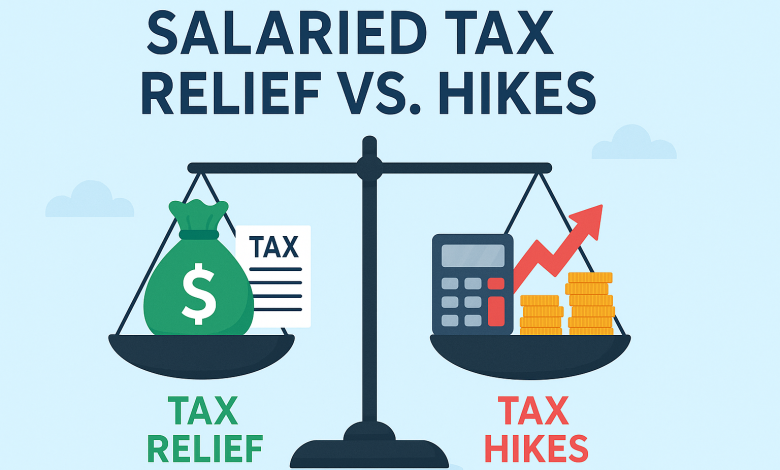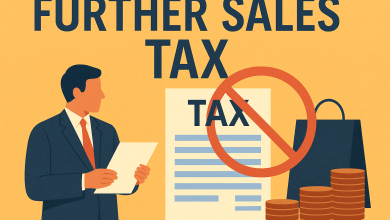Salaried Tax Relief vs. Hikes: Progressive Changes in Budget 2025–26

The federal budget for fiscal year 2025–26, unveiled on June 10, 2025, introduces significant reforms targeting the salaried class in Pakistan. These reforms strike a balance between targeted tax relief for low- and middle-income earners and increased revenue mobilization from higher-income brackets. Here’s a detailed analysis of what the changes mean for salaried individuals.
1. Tax Slab Revisions: Relief Where It Matters Most
The budget slashed tax rates across the first three income slabs:
-
PKR 600,001–1,200,000: Tax reduced dramatically from 5% to 1%, resulting in annual savings of roughly PKR 24,000 for a person at the top of this slab.
-
PKR 1,200,001–2,200,000: Rate lowered from 15% to 11%, and the fixed tax component dropped from PKR 30,000 to PKR 6,000.
-
PKR 2,200,001–3,200,000: Rate decreased from 25% to 23%, and the fixed portion reduced from PKR 180,000 to PKR 116,000.
For higher incomes, the percentage rates remain the same, but the fixed sums for the following brackets have been slightly reduced, offering modest relief. Meanwhile, a one percentage-point cut in the surcharge for incomes above PKR 10 million aims to stem potential brain drain.
2. Who Gains Most from These Adjustments?
The revised slabs represent meaningful gains for a broad segment of earners:
-
A person earning PKR 100,000 per month (PKR 1.2 million annually) now pays PKR 6,000 instead of PKR 30,000—an 80% reduction in tax liability.
-
Middle-earners around PKR 250,000 per month save about PKR 6,667 monthly, based on tax calculator estimates.
-
High-income earners (PKR 12 million annually) are expected to save over PKR 200,000 in taxes over the year.
A report suggests that salary-drawers tend to pay five times more tax than retailers and exporters combined—approximately PKR 331 billion—highlighting why the government is keen to offer this segment relief and maintain compliance.
3. Salary and Pension Hikes: Setting a Context
Parallel to tax cuts, the government also approved a 10% pay hike for federal employees and a 7–10% increase in pensions. These increases cushion the impact of inflation but have also constrained fiscal space, a fact highlighted by the FBR chair, who clarified that cash withdrawal withholding tax was raised to 0.8%, not 1% as initially announced.
4. Balancing Relief with Revenue Goals
Despite welcoming the relief, critics argue that the exemptions don’t address deeper structural issues:
-
The tax-exemption threshold remained at PKR 600,000, far below the PKR 1.2 million demand from the salaried class lobbies.
-
Additional burdens on salaried individuals stem from increased taxes on areas such as bank interest, mutual fund dividends, and digital transactions, which offset the slab relief.
-
Over 98% of Pakistanis don’t pay income tax, and widening the tax base remains a priority under IMF conditions—yet the budget offers little direction on including agriculture and retail sectors.
5. Comparison with Previous Years
-
The previous fiscal year had seen higher rates, but higher fixed sums; the current budget rebalances that more favorably for salaried individuals earning up to PKR 3.2 million.
-
A slight reduction in surcharge and super-tax for higher earners also improves Pakistan’s standing against regional peers, which charge significantly more.
6. Practical Impact on Take-Home Pay
Consulting an income-tax saving calculator reveals:
-
Low-earners (up to PKR 50,000/month) remain exempt.
-
A middle-income employee (earning PKR 250,000 per month) sees their monthly take-home pay rise by approximately PKR 6,667.
-
Higher earners (earning over PKR 1 million per month) also experience sizable nominal gains—around PKR 18,000 per month.
These savings, while modest for high earners, are a substantial percentage-wise for middle-income professionals.
7. The Broader Perspective
Despite offering relief, the slashed rates are not transformative:
-
The failure to raise the exemption floor keeps lower-middle-income families within the tax net.
-
Additional levies—on digital consumption, bank profits, mutual funds, and interest income—dilute the gains for salaried individuals.
Still, the government argues that these reliefs support disposable income, reduce inflationary pressure, and align with the IMF-mandated fiscal consolidation of a 4.8% GDP deficit and a 4.2% GDP growth target.
Final Assessment
Pakistan’s Budget 2025–26 provides targeted relief for salaried individuals, particularly those earning between PKR 600,000 and PKR 3.2 million. Monthly take-home pay increases by hundreds to thousands of rupees, offering near-term financial comfort.
However, the unchanged exemption threshold, coupled with indirect tax hikes elsewhere, tempers this benefit. True structural reform—entailing a widened base, comprehensive digitalization, and inclusion of agriculture and retail sectors—remains unfinished business.
For salaried individuals:
-
If your taxable income is ≤ PKR 3.2 million, you’re likely to see meaningful relief.
-
If you earn substantially more, benefits taper off, and surcharges remain largely intact.
-
And if you’re outside salaried income—but taxed in other forms—you may face higher costs or lower returns elsewhere.
